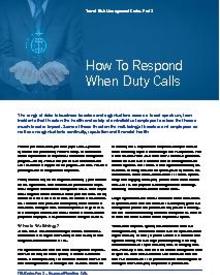Fraud and Compliance
Travel Risk Management: It's Time to Take the Next Step Towards Your TRM Plan
In the first two parts of this series, we explained why travel risk management (TRM) is so important for businesses, and why coordinated data capture is key to your TRM plan. Now, how to tie it all together? Fulfillment of your duty-of-care obligations will ultimately require the successful integration of multiple components. Here are a few things you must do to make that happen.
1. Know Who's on Lookout
Without the right data, you won't be able to locate and respond to your travelers promptly in a crisis - you may not even know that crisis is happening! What this looks like depends on your organization. If you work with a TMC, it will likely have risk-monitoring capabilities. If not, there is the option to assemble data, technology and resources in-house, or to utilize third-party resources to varying degrees. Larger, multi-national companies often work with such a full-service, third-party global risk management provider that can take care of pre-travel warnings, emergency communication, medical assistance and more.
2. Identify Your Stakeholders
Do you know who in your organization is responsible for what in the event of a crisis? At a small company, this could be a group comprised of travel decision makers and a CFO. Larger organizations need to plan for multiple stakeholders, combining departments like travel management, HR, legal and security. If headcount allows, the Global Business Travel Association (GBTA) recommends having different teams be responsible for specific incidents, such as a natural disaster team or road accident team.
3. Practice, Practice, Practice
Your TRM is not a "one-and-done" exercise. To be effective, you must not only have a master plan, but that plan needs to be periodically reviewed and updated to remain relevant to your businesses' needs and changing external conditions. That also means engaging in incident management exercises so that those stakeholders can practice their TRM procedures before an incident actually arises. Time is not on your side when something goes wrong, and having a coordinated team that's ready to react will save precious minutes when it counts.
Are you ready to take the next step towards managing your risk? To begin mapping out your plan, see the third installment of our travel risk management whitepaper series: How to Respond When Duty Calls, produced by the BTN Group. Then, see how Concur Locate enables you to fulfill your duty-of-care responsibilities.
Part one: Four Reasons Why Travel Risk Management is a Business Imperative
Part two: Why Data Integration is Key to Your Travel Risk Management plan

